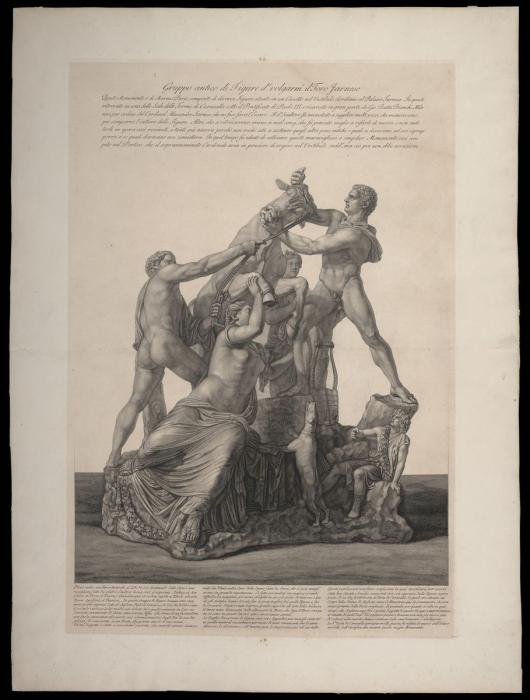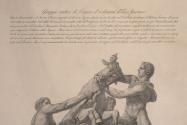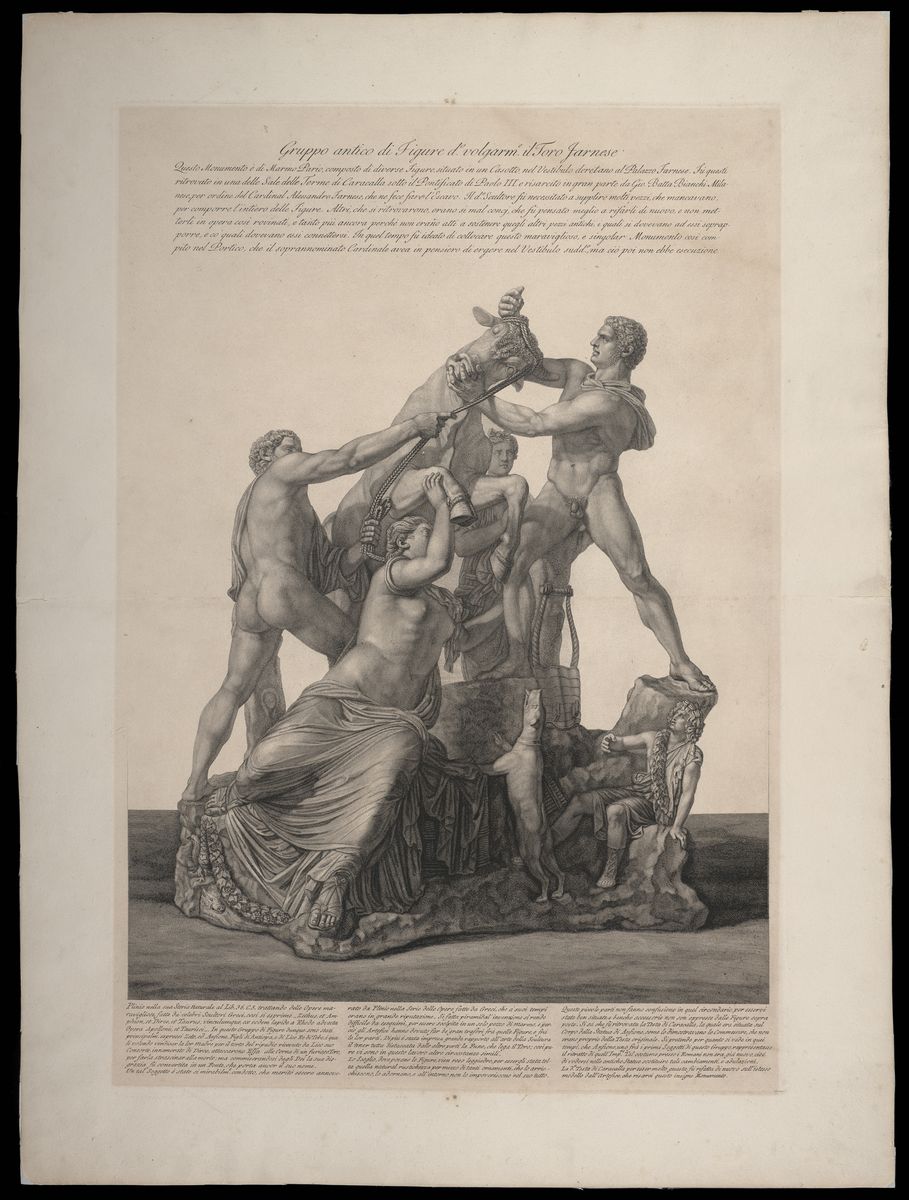The Farnese Bull, from the Collection of the Most Beautiful Statues from Rome
Artist:
Francesco Piranesi
(Italian, 1758 - 1810)
Place made:Rome, Italy
Culture: Italian
Date: 1786
Medium: Etching on paper
Dimensions:
34 × 25 in. (86.4 × 63.5 cm)
Credit Line: San Antonio Museum of Art, gift of Merribell Maddux Parsons in honor of Dr. Jessica Powers
Object number: 2016.32.1
Inscribed: Title, top center: Gruppo antico di Figure d.° volgarm.e il Toro Farnese
[Ancient Group of Figures commonly called the Farnese Bull]
At top, beneath the title:
Questo Monumento è di Marmo Pario, composto di diverse Figure situato in un Casotto, nel Vestibulo deretano al Palazzo Farnese. Fù questi ritrovato in una delle Sale delle Terme di Caracalla sotto il Pontificato di Paolo III. e risarcito in gran parte da Gio. Batta Bianchi Milanese, per ordine del Cardinal Alessandro Farnese, che ne fece fare l’Escavo. Il d.o Scultore fù necessitato a supplire molti pezzi, che mancavano, per comporre l’intiero delle Figure. Altri, che si ritrovarono, erano sì mal concj, che fù pensato meglio a rifargli di nuovo, e non metterli in opera così rovinati, e tanto più ancora perchè non erano atti a sostenere quegli altri pezzi antichi i quali si dovevano ad essi soprapporre, e co’ quali dovevano essi connettersi. In quel tempo fù ideato di collocare questo maraviglioso, e singolar Monumento così compito nel Portico, che il soprannominato Cardinale avea in pensiero di ergere nel Vestibulo sudd.o, ma ciò poi non ebbe esecuzione.
[This monument is made of Parian marble, composed of several figures and located in a shed, in the vestibule behind the Palazzo Farnese. It was found in one of the rooms of the Baths of Caracalla during the pontificate of Paul III and restored in large part by Gio. Batta Bianchi Milanese, by order of Cardinal Alessandro Farnese, who had it excavated. The named sculptor had to supply many pieces that were missing to complete the figures in their entirety. Other (pieces) that were found were so badly made that it was thought better to make them again from new and not to put them back in the work so ruined, all the more so because they would not have been able to support the other ancient pieces that had to be placed on top of them, and with which they had to be joined. At that time it was envisioned to place this marvelous and singular monument thus restored in the portico, which the above-named Cardinal had thought to erect in the above-mentioned vestibule, but this was not then carried out.]
At bottom, in 3 columns of 10 lines each:
Plinio nella sua Storia naturale al Lib. 36.C.5. trattando delle Opere maravigliose, fatte dà celebri Scultori Greci, così si esprime “Zethus, et Amphion, et Dirce, et Taurus, vinculumque, ex eodem lapide a Rhodo advecta Opera Apollonii, et Taurisci”. In questo Gruppo di Figure dunque sono stati principalm.e espressi Zeto, ed Anfione, Figli di Antiopa, e di Lico Re di Tebe, i quali volendo vendicar la lor madre per il torto del ripudio ricevuto da Lico suo Consorte, innamorato di Dirce, attaccarono Essa alle Corna di un furioso Toro, per farla strascinar alla morte; ma commiserandosi dagli Dei la sua disgrazia fù convertita in un Fonte, che porta ancor il suo nome.
Un tal Soggetto è stato sì mirabilm.e condotto, che meritò essere annoverato da Plinio nella Serie delle Opere fatte da Greci, che a suoi tempi erano in grande riputazione. Sì fatta piramid al’invenzione si rende difficile da eseguirsi, per essere scolpita in un solo pezzo di Marmo, e perciò gli Artefici hanno dovuto far de’ gran trafori fra quelle Figure, e fra le lor parti. Di più è stata impresa grande rapporto all’arte della Scultura il tener tutta distaccata dalle altre parti la Fune, che lega il Toro; così pure vi sono in questo lavoro altre circostanze simili.
Lo Scoglio, dove posano le Figure, vien reso leggiadro, per essergli stata tolta quella natural rustichezza per mezzo di tanti ornamenti, che lo arricchiscono, lo adornano, e all’intorno non lo impoveriscono nel suo tutto. Queste piccole parti non fanno confusione in quel circondario, per esservi state ben situate, e benchè accessorie non son’oppresse dalle Figure sopra poste. Si sà che fù ritrovata la Testa di Caracalla, la quale era situata sul Corpo della Statua di Anfione, come lo dimostravano le Commessure, che non erano proprie della Testa originale. Si pretende per quanto si vede in quei tempi, che Anfione, uno frà i primi Soggetti di questo Gruppo, rappresentasse il ritratto di quell’Imp.re Tal costume presso i Romani non era già nuovo, cioè di vedersi nelle antiche Statue sostituire tali cambiamenti, e adulazioni. La d.a Testa di Caracalla per esser molto guasta fù rifatta di nuovo sull’istesso modello dall’Artefice, che risarcì questo insigne Monumento.
[Pliny, writing about impressive works made by famous Greek sculptors in his Natural History at Book 36.5, writes “Zethus, and Amphion, and Dirce, and the Bull, and the rope, in the same sculpture, are works of Apollonius and Tauriscus imported from Rhodes”. In this group of figures are thus principally depicted Zethus and Amphione, children of Antiope and of Lycus, king of Thebes, who wanted to avenge their mother who had wrongly been repudiated by Lycus her consort, enamored of Dirce, (and they) attached (Dirce) to the horn of a furious bull, in order that she would be dragged to death; but through the commiseration of the gods her disgrace was converted into a fountain, which still bears her name.
Such a subject is so wondrously rendered, that it deserved to be mentioned by Pliny in the series of works made by Greeks, which in his time held a great reputation. Thus made in inventive pyramidal (form) it was difficult to execute, for it was carved from a single piece of marble, and thus the artists had to make large openings between those figures and their limbs. Furthermore the carving of the rope, which joins to the bull, completely separately from the other parts is a great feat of sculpture; and there are many other similar passages in this work.
The rock, on which the figures stand, is rendered gracefully, so that its natural ruggedness is removed by means of the many ornaments that enrich it, adorn it, and surround it not impoverishing any part. These small details do not create confusion in that zone, because they are well placed, and although secondary are not overwhelmed by the figures placed above. One knows that the head of Caracalla was found, the one placed on the body of the statue of Amphion, as the measurements demonstrate, which were not correct for the original head. It seems that as it was seen in those times, that Amphion, one of the main subjects of this group, presented the portrait of that emperor. Such a practice was not new among the Romans, that is to see substituted in ancient statues such alterations, and adulations. The mentioned head of Caracalla, because it was much damaged, was remade from new on the same model by the sculptor, who restored this distinguished monument.]
(Translations by J. Powers, 2021)
Provenance: Merribell Maddux Parsons, by gift to the San Antonio Museum of Art, 2016
Label Text
Francesco Piranesi trained with his father, the celebrated architect, designer, sculptor, and printmaker Giovanni Battista Piranesi (1720–1778). Their views of Roman monuments found a ready audience among the many foreign aristocrats who traveled to Rome in the eighteenth century. This print portrays the so-called Farnese Bull, an ancient Roman statue of the mythological punishment of Dirce, who mistreated her niece, Antiope; Antiope’s sons exacted revenge by tying Dirce to a bull. Piranesi provided the image with an extensive commentary in Italian that describes the discovery of the statue and a passage in the ancient Roman author Pliny the Elder’s Natural History on its sculptors. (J. Powers, 2021)
Not on view
In Collection(s)
The San Antonio Museum of Art is in the process of digitizing its permanent collection. This electronic record was created from historic documentation that does not necessarily reflect SAMA's complete or current knowledge about the object. Review and updating of such records is ongoing.





 This resource has been made possible in part by the National Endowment for the Humanities: Exploring the Human Endeavor.
This resource has been made possible in part by the National Endowment for the Humanities: Exploring the Human Endeavor.
